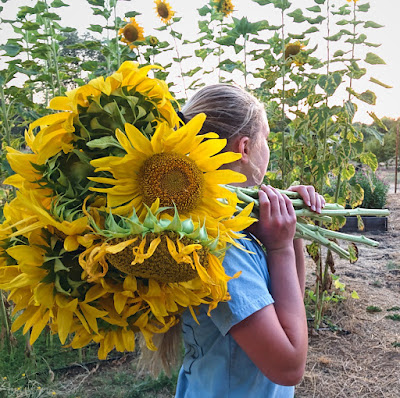American Flowers Week hopes to put local blooms on more tables
Farm-to-vase celebration urges consumers to think about where and how bouquets grew
By Debbie Arrington
 |
| Photos courtesy Happy Road Farm |
Happy American Flowers Week! Celebrate with a bouquet.
Never heard of it? This farm-to-vase commemoration is just beginning to sprout. Now in its fourth year, American Flowers Week runs through July Fourth and celebrates the nation’s flower farmers, mostly small independent operations and often women. It also salutes florists who buy American-grown blooms and efforts to bring cut-flower production back home.
It’s the brainchild of Debra Prinzing, the mother of the “Slow Flowers” movement. What Slow Food did to gain consumer interest in where food comes from, Prinzing hopes to do for the floral industry via sourcing information and consumer awareness.
Friday, June 29, Prinzing hosts the second Slow Flowers Summit in Washington, D.C., a one-day conference billed as the “TED Talk for flower lovers.”
Once a flower powerhouse, America now imports more than 92 percent of its cut flowers. That’s about $7 billion in imported flowers annually. That shift (primarily to South American growers) put nearly 60 percent of all U.S. flower farmers out of business.
On the bright side, U.S. flower farming is making a comeback, Prinzing noted. Since 2007, America has seen 16 percent growth in the number of farms devoted to cut flowers and foliage. Of the cut flowers grown domestically, about three-quarters come from California.
Before heading east, the Seattle-based author and flower activist held a one-day brainstorming session for Sacramento-area flower farmers and floral designers at Maple Rock Gardens in Loomis. Prinzing urged the group of 20-plus flower people to work together to get a common message across: Buy local and support local farms.
“Slow Flowers is a national community of growers and florists,” Prinzing explained. “Together, we’re growing businesses organically. That’s the story here – local flowers have a story. Where do they come from? How are they grown? Those stories will help people reconnect with the living Earth.”
Some florists have made a commitment to buy local. Why? Fresher is better.
“About 75, 80 percent of our flowers now come from California growers,” said Alicia Relles of Relles Florist in Sacramento. “We want our flowers to be all within one day of our shop.”
Knowing where and how your flowers are grown is important for consumers, noted Lisa Thibodeau of Happy Road Farm in Loomis.
 “When you know the source of your fresh flowers, you know the way they are grown and you are ensured that the flowers are not sprayed with harmful pesticides or picked by workers who live in extreme poverty,” Thibodeau said. “The flowers have integrity, and a grower who takes responsibility for their quality.”
“When you know the source of your fresh flowers, you know the way they are grown and you are ensured that the flowers are not sprayed with harmful pesticides or picked by workers who live in extreme poverty,” Thibodeau said. “The flowers have integrity, and a grower who takes responsibility for their quality.”
On one acre, Thibodeau grows such seasonal favorites as daffodils, irises, sweet peas, dahlias, cosmos, sunflowers, yarrow and strawflowers.
“We sell our flowers to shops locally here in Loomis and at the PlacerGrown Loomis farmers market, which is held July and August,” Thobodeau said. “We also offer a spring CSA delivery.”
Why should Sacramento flower lovers buy locally grown flowers?
“Because you can!” Thibodeau said. “The closer the grower is to you the better. Flowers grown close-by are fresher, last longer, and have a smaller (carbon) footprint. There are so many wonderful flower growers here in California, it would be a shame not to seek them out!”
For more on American Flowers Week: www.AmericanFlowersWeek.com


Debbie and Kathy! Thank you for sharing our story about #americanflowersweek and how people can get involved with growing their own cutting garden, buying/supporting local flower farmers, and engaging in the Slow Flowers Movement! I am so impressed with Sacramento Digs Gardening and I wish you all the success!
ReplyDeleteLet's keep in touch!